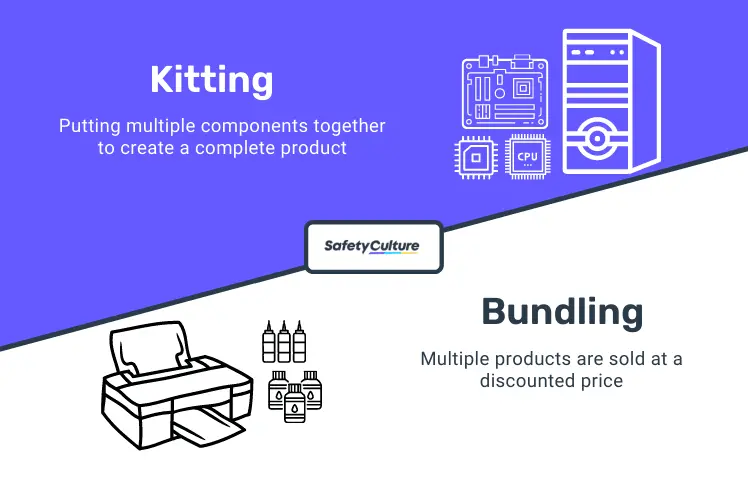What is a Kitting Process?
The term “kitting” comes from packaged items in a box called a “kit.” Kitting is often used in manufacturing and assembly operations, as it allows businesses to consolidate inventory and it simplifies the shipping process. This ordering process saves time and money because the vendor doesn’t need to keep track of individual stock pieces. Instead, they need to maintain a single list of items and quantities, making it easier to find the right piece of inventory when needed.
In addition to its use in mass production, kitting can also be customized to create unique products for specific applications. For example, a company might create a kit that includes all the parts needed to assemble a piece of furniture. Businesses that use kitting can increase efficiency and reduce costs by reducing the time and labor required to assemble individual components.
The Difference Between Kitting and Bundling
The terms kitting and bundling are often used interchangeably, but there is a big difference between the two.

The Difference Between Kitting and Bundling
Kitting is putting together multiple components to create a complete product. Suppose you were selling computers, you would kit together the CPU, motherboard, RAM, and hard drive to create a complete system. The benefit of kitting is that it allows customers to buy everything they need in one go without having to source each component separately. It also will enable businesses to upsell by including optional extras in the kit.
On the other hand, bundling is when multiple products are sold at a discounted price. An example might be to package a printer and ink cartridges together and offer them for less than the customer would pay if they bought them separately. Bundling is often used to clear old stock or promote slow-selling items. You can also bundle higher-priced items with lower-priced ones to encourage customers to buy them.
What Are the Benefits?
The following are some of the main benefits of kitting:
- Organization Efficiency
Kitting is a great way to make your order fulfillment faster and more efficient. You can easily create kits of items that are frequently purchased together. It helps you reduce the number of SKUs you need to stock and helps optimize warehouse space. Kitting also speeds up your fulfillment process because you can quickly locate what you need for your most popular product combos. - Simplify Your Shipping Process
Kitting your products makes them easier to ship. You can automate the process by printing shipping labels and weighing your kitted items before sending them out. It can save you time and money. - Improve Packaging
Packaging products together in a custom-size box reduces the number of packages shipped and handled. That means less handling costs and less chance of damage during transit. - Reduce Warehousing Cost
Kitting is an essential process in warehouse operations because it allows for more efficient use of storage space. Standardizing inventory by combining items into kits saves time and money. The picking, packing, and shipping of separate items individually require more time and resources than when these items are combined as parts of a single package. - Increase Sales
Kitting can help you save money when you’re selling too many items. For example, you could group several similar items into a set price. It enables you to reduce the number of different SKUs you need to list on your website.
Steps in Kitting and Fulfillment
- Receiving an Order
The customer places an order for one of your product kits. It may be a single kit or a recurring subscription service delivered on a particular day in the next cycle. - Picking and Packing the Kit for Shipping
The picker will need to retrieve the product kit from the warehouse’s designated area if it is pre-assembled. The picker will need to gather all of the kit’s contents and pack them correctly if built on demand. - Scanning and Labeling
The kit must be labeled correctly with a shipping label and scanned to indicate that it is a single SKU with a separate list of items, after which it must be shipped. - Shipping to the Customer
The finished kit is sent to the customer, eagerly anticipating its arrival.
Uses Across Industries
Kitting is a process used in various industries to simplify order fulfillment and save time and money. Here’s how some industries are using kitting:
- Logistics
In the logistics industry, kitting groups multiple items shipped to the same destination. It helps save on shipping costs and ensures that all items arrive together. - Ecommerce
In the e-commerce industry, kitting is used to create bundles of frequently purchased products together. It helps save on shipping costs and reduces the number of SKUs that need to be stocked. - Warehouse
In warehouse management, kitting is used to group frequently purchased products together. It helps optimize storage space and makes finding what you need to fulfill an order easier. - Manufacturing
In manufacturing, kitting is often used to group the parts needed to assemble a product. It helps save time and money by reducing the need to pick and pack each part individually. - Retail
In retail, kitting is used to group products frequently purchased together. It helps save time and money by reducing the need to pick and pack each product individually. You can also create custom gift bundles or promotional packages using kitting.
Create Your Own Customized Kitting Checklist
Eliminate manual tasks and streamline your operations.
Get started for FREEThe Importance of Using Apps
When you use kitting software, you can easily track each process step. It helps you keep track of everything that needs to be done and when it needs to be completed.
With kitting software, you’ll also be able to identify any problems with your production schedule quickly. If you need to extend your delivery date, you can easily adjust your schedule.
Kitting software also helps you avoid mistakes during the assembly process. For instance, if you accidentally put the wrong color screws in your product, you can easily remove them and replace them with the correct ones.
It’s essential to find a reliable company that offers this type of kitting software as you wouldn’t want to lose time wondering what you missed.




